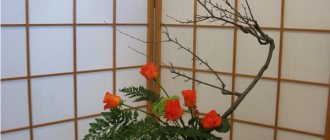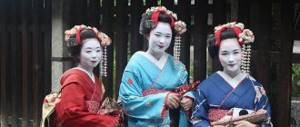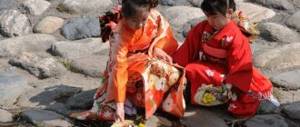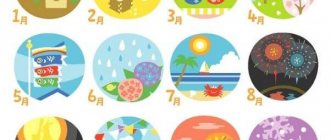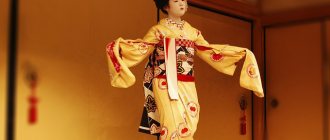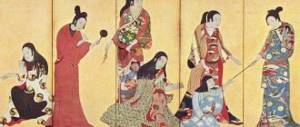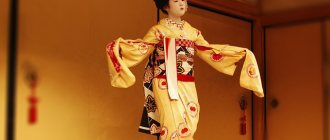What it is
Ikebana (ekibana) - translated from Japanese means “revived flower” or “second life of a flower.” Before the advent of Buddhism, the Japanese practiced Shintoism: they believed in spirits that lived in flowers, plants and even stones. The ritual of flower offerings did not disappear with the advent of new philosophy.
The first masters were male monks. By the 15th century, ikebana turned into a secular applied art.
Where to find useful information on ikebana
- Mediasole.ru - seven simple master classes on creating Japanese bouquets with your own hands.
- Pinterest.ru - on this site you can always look for ideas for handmade items, including ikebana.
- “Fair of Masters” - in the “Master Classes” section there are several original ideas and lessons on ikebana.
- Ikebana-ikenobo.ru is the official website of the Russian branch of the Ikenobo Institute. Here you can learn about exhibitions, look at photos from master classes, and even sign up for training.
Art or philosophy
Only a nature inclined to contemplate the surrounding world can correctly arrange a Japanese bouquet. The master conveys a view of human life, the world around us and man’s place in the ever-changing cycle of existence. The symbolic language of flowers helps to express feelings of joy, sorrow, sadness, longing or hope.
Composition is a ritual act that requires skills and high artistic flair. Ikebana displays a model of the universe, talks about feelings or teaches a lesson in moral behavior. Ikebana can convey a message of love or an assurance of friendship.
Symbolism
Unlike Western-style bouquets, ikebana is subject to strict laws of linear construction. The number of flowers, color combination and rhythm are predetermined.
The composition has three symbolic lines:
- The main long line of Xing means a male person and his high calling.
- The second line, Soe, symbolizes creativity and childhood.
- The third, shortest line, Hikae, speaks of the feminine and earthly beginning.
- Jyushi - short auxiliary lines.
Three main axes connect together man, heaven and earth, or three human hypostases.
The master conveys indifference or indifference with horizontal lines. Joy or elation - with diagonal bends. Grief is represented by drooping or descending strokes.
Color
Leaf and flower masses should be in harmony with the vase, and one of the main shades of the array should also be combined with it.
Figurative language of individual colors and shades:
- Black color symbolizes cold, darkness, night.
- Green – youth, rebirth.
- Red – passionate feelings, fire.
To convey positive emotions, flowers of warm, rich shades are required: scarlet, orange, yellow. For the main background, a yellow or gold tint (the color of imperial grandeur) is often selected. Gold illuminates flowers and herbs, radiating warmth.
Blue, cyan and violet shades are appropriate for discreet or mourning compositions. The color contrast, classic for folk art, is reflected in Japanese art. Popular color contrasts include white/red, yellow/violet, blue/orange and blue/red.
The main floral mass resembles the background of a painting. The artist applies contrasting strokes to the given background. Basic shades should not conflict with each other.
The language of flowers and plants
The language of flowers tells the story of the passage of time from the past to eternity. Blooming flowers, dry branches, herbariums, and seed pods help the master convey a sense of the past. Buds and young shoots speak of the future, and barely opened buds speak of the present.
- Rose flowers and pine branches symbolize blooming youth and longevity.
- Peony and pine - youth, prosperity.
- Bamboo – peace, longevity, respect for father by son.
- Orchid is joy.
- The branch of an apricot tree is feminine grace.
- Jasmine flowers – enjoyment of life.
The symbolic language of the elements reveals to the viewer the details of the landscape: a chrysanthemum flower is thin river streams, a pine branch is rocks or stones.
Moribana
Let's take a closer look at what this style is. The compositions reflect the philosophy of naturalism; all the works of the masters look three-dimensional and three-dimensional. The vases are all low, but can have different shapes: round and oval, square and rectangular.
This style has three main rules for composing a bouquet. They are called Sin (sky), Soe (man), Tai (earth). The ratio of these formative elements should be in the proportion 7:5:3. The size of the vase is also taken into account. First, the main elements are laid out on metal rods, then depth is created thanks to additions. They connect all the details together.
There are 3 forms in this style:
- Tekutai has a vertical bouquet structure. Long straight stems are used. These are bamboo, gladiolus, narcissus. The main element – Sin – is installed vertically. Deviation is only allowed by 30°.
- Xiatai. An oblique form of line construction is used here. Branches with beautiful and unusual bends of the trunk are often used. The apex now deviates much more than 30°. It seems that the bouquet was tilted by a strong wind.
- Suitai consists of several cascades. Hanging plants are used. The Xing main piece can extend below the vase, creating a beautiful curve. Such vases look impressive on high shelves or shelves.
The history of the origin of art and its development
Art originated in China in the 6th -7th centuries. AD Pine and cypress branches, rose and lotus flowers are the first plant elements for the arrangement. Plants were placed in bronze vessels.
In the X-XII centuries. The religious ritual of offering to the gods is gradually abolished, and secular culture begins to flourish. Ikebans decorated the emperor's palace and the estates of aristocrats. Arrangement competitions were held at the emperor's court.
In the 16th century, the tea ceremony appeared. Ikebana in restrained, calm shades and simple forms is located in the gazebos during tea drinking.
In the XVII-XIX centuries. The main directions and schools finally took shape, and art itself became the national treasure of Japan.
Nageire
Ikebana from flowers of this style has the same basic shapes and proportions as the previous one. The difference is represented by the shape of the vessel in which the composition is placed. For Nageire, a tall vase is taken, the narrow neck of which holds the plants. Additional fastening elements are also used - crosses, split branches, wooden spacers in the shape of the letter V.
This style conveys not only the beauty of natural landscapes, but also reveals the graceful curves of flower stems and plant branches.
Schools and styles
The first school was opened in the city of Kyoto in the 15th century by the monk Ikenobo Senkei. During this period, composition was taught as one of the elements of religious service. The first ikebana had a high main line 1-1.5 m in height. In the space of the temple they symbolized man's desire for the gods.
Rikka's style was distinguished by grandiose designs and precision of lines. Bamboo stems and pine branches were taken as the basis, and other plant elements were considered additional. In Rikka style, plants symbolized the sacred mountain.
Several masters worked on one piece at the same time. They studied at the Ikenobo school all their lives, and achieved the title of master only after 20 years of study. In the 21st century, Rikka ikebana is composed for major religious secular holidays.
Nageire
Simple and laconic compositions in tall vases appeared in the 16th century along with the tea ceremony. The simplicity and naturalism of the style showed the influence of the Ikenobo school: the height of a vessel with one towering flower was up to 1.5 m.
Shoka
The secular, secular style that replaced Ricca was formed in the 18th century. It reflects the traditional principle of the triangle. Linear forms indicate the symbolic interaction of man with the earth and sky. Plants were placed in both low and tall vases.
Moribana
In 1897, Unshin Ohara founded a new school named after him. The styles of Moriban and Hake stood out in it.
At the beginning of the 19th century, new flowers and plants were brought to Japan from European countries. They were not used in traditional schools. Under the influence of Western culture, a new style emerged. It combined naturalism and the features of the area, the natural beauty of living plants.
For the Heika style, narrow vases are used, and for Moribana, low bowls are used. Plants are supported on the edges of the vase or on specially provided wooden supports. It is permissible to add water to containers with flowers. In addition to traditional materials, stones, mosses and branches appear. Kenzan - a holder for fixing flowers is placed at the bottom of the bowl.
Sogetsu
After two world wars, under the influence of European culture, a free style and an avant-garde young school was formed, founded in 1929 by the artist Sofu Teshigahara. In old schools it was unacceptable to use elements of inanimate nature or artificial materials. But the artist and sculptor decided to modernize Japanese applied art. He uses glass, stones, metal, porcelain and even ropes and chains.
Among the masters of the 21st century, unusual form, novelty and dynamism come first. For example, the branches should be curved in an unusual and even whimsical way to attract the viewer's attention.
Beginning of work
First, when working on autumn ikebana, a vessel is selected. In our case, this role is played by a simple clay vase. You also need to have a foundation. It is best to buy a metal stand in the store - a kenzan. If it is not there, then you can nail several nails in a row onto a wooden stand yourself.
The three main elements of our autumn ikebana are represented by yellow chrysanthemum and branches with red barberries. They are easy to find in autumn in parks or on slopes.
All that remains is to assemble the composition, taking into account the proportions of the elements. Remember that this is not a bouquet, it does not require pomp. It will be enough to create such a simple plot to begin with.
Materials
Traditional materials are plant elements: blossoming flowers, buds, branches with swelling buds, leaves, sprigs of pine needles, fruits and dry grass.
Auxiliary elements are clay, bronze, ceramic vessels, auxiliary structures made of glass, metal and plastic, stones, minerals, sand and water.
For flower mass, the most common choices are: orchids, gerberas, hyacinths, asters, peonies, roses, begonias and crocuses.
The composition is created by an inner feeling - the ability to see and convey the beauty and harmony of the plant world.
Jiyuka
Freedom of style is manifested in the originality of the choice of material; this is a kind of surrealism of ikebana made from natural materials. It combines the ancient art of bouquet arranging with the modern eye of an artist. Here, any modification of the shape of the leaves, the addition of materials, both natural and inanimate, is possible. Dry herbs and leaves, fruits, glass and stones, and plastic are often used. An unusual shape of the vessels in which the masterpiece is created is also chosen.
The free style of bouquets allows for the use of mixing other styles. Plant materials from the surrounding nature can be used, geometric symbolism and color mixtures are added. Modern textured materials allow the imagination of artists to run wild, embodying the most reckless ideas.
The Jiyuka style can create countless looks by combining plant and man-made materials.
How to make Ikibana with your own hands
To make the ikebana look like a single whole, work begins from the center of the composition. It is installed perpendicular to the base. The other two lines are placed asymmetrically and at an angle, depending on the idea of the work. The main line is represented by a flower, a branch of a deciduous or coniferous plant, or decorative elements. Curved branches make the composition dynamic.
The theme of the composition is chosen with an eye to the current time of year. Flowers, wood elements and decor reflect the state of nature.
A flower vase should not attract attention with bright colors, texture or decor. Try to find a discreet piece in earthy tones.
Autumn bouquet
The bright colors of autumn foliage, rich colors of asters, dahlias, chrysanthemums, carnations will set the mood of the autumn composition.
Additional elements: pumpkin baskets, driftwood, acorns, chestnuts, nuts, citrus fruit peels. A glycerin solution will help preserve the appearance of yellow and red leaves.
Fix the selected decor using floral sponges, polystyrene foam or plaster. Sand, pebbles, and minerals poured on top will help disguise the fastening element.
Winter's Tale
Cold season floristry is distinguished by rich, bright colors. A winter piece brings a festive atmosphere into the home. Basic winter decor: pine needles, cones, nuts, citrus peels, viburnum bunches, rowan berries, dried fruits, garlands, beads. Important colors: dark green, scarlet, rich cold blue, silver, gold. The basis is wicker baskets or wire frames.
Spring Summer
Spring bouquets are distinguished by delicate buds, young branches with swollen buds. Delicate fresh shades predominate: pastel colors, light brown, mint, white, bright yellow. Summer herbs and flowers are placed in vases with water using kenzon.
We found several thematic videos to show the work of masters and students. On Internet resources there are calls to replace fresh flowers and plants with paper products made with your own hands. This choice is justified by the fragility of living plants and the disproportion of the effort expended. Wanting to warn beginners, we note that artificial flowers will not bring even a small amount of aesthetic pleasure. Even 100 years ago, decorations made from artificial flowers were considered a sign of extreme poverty or philistinism.
There are over 3,000 schools in Japan, with slight differences in design. The basis of the compositions is the principle of three geometric lines. Each school has its own symbols.
An ancient legend
In Japan, there is a legend about the origin of this art. One day a hurricane swept across the country, during which many plants and flowers died as a result of strong wind and rain. Buddhist monks collected all the broken flowers from the garden and came to the temple with prayer, asking God for mercy to restore the gardens.
Buddha heeded the requests of the clergy, and the gardens again began to delight people with beautiful plants. Since then, the monks gratefully bring beautifully arranged asymmetrical bouquets to the temple, trying to please the deity.
